This site uses cookies as defined in our Cookie Policy, by continuing to use this site you agree to their use.
Continue
Fares shown include 1 pre-hotel night in Dublin – total trip duration 16 nights starting 17/05/2023
Explore the rugged west coast of Ireland, journey through hundreds of islands and enchanting peninsulas. See some of the highest cliffs in Europe and discover unique flora and fauna. Blessed with fine weather, we ship cruise around The Skellig Islands that includes a 6th century beehive hut monastery – a UNESCO World Heritage Site, and a large colony of puffins and gannets. In Scotland’s equally wild and wind-ravaged west coast, we marvel at striking ... basalt columns at Fingal’s Cave, learn about the country’s Christian origins at Iona Island, revel in remarkable archaeological treasures and encounter some of the largest breeding colonies of northern gannets in the world.
| Arrive | Depart | ||||||
| 17th17 | MayMay | 202323 | 1 night accommodation before your cruise, staying in Dublin | ||||
| 18th18 | MayMay | 202323 | Dublin, Ireland, embark on the Sylvia Earle | ||||
| Dublin is making a comeback. The decade-long "Celtic Tiger" boom era was quickly followed by the Great Recession, but The Recovery has finally taken a precarious hold. For visitors, this newer and wiser Dublin has become one of western Europe's most popular and delightful urban destinations. Whether or not you're out to enjoy the old or new Dublin, you'll find it a colossally entertaining city, all the more astonishing considering its intimate size.It is ironic and telling that James Joyce chose Dublin as the setting for his famous Ulysses, Dubliners, and A Portrait of the Artist as a Young Man because it was a "center of paralysis" where nothing much ever changed. Which only proves that even the greats get it wrong sometimes. Indeed, if Joyce were to return to his once-genteel hometown today—disappointed with the city's provincial outlook, he left it in 1902 at the age of 20—and take a quasi-Homeric odyssey through the city (as he so famously does in Ulysses), would he even recognize Dublin as his "Dear Dirty Dumpling, foostherfather of fingalls and dotthergills"?For instance, what would he make of Temple Bar—the city's erstwhile down-at-the-heels neighborhood, now crammed with cafés and trendy hotels and suffused with a nonstop, international-party atmosphere? Or the simple sophistication of the open-air restaurants of the tiny Italian Quarter (named Quartier Bloom after his own creation), complete with sultry tango lessons? Or of the hot–cool Irishness, where every aspect of Celtic culture results in sold-out theaters, from Once, the cult indie movie and Broadway hit, to Riverdance, the old Irish mass-jig recast as a Las Vegas extravaganza? Plus, the resurrected Joyce might be stirred by the songs of Hozier, fired up by the sultry acting of Michael Fassbender, and moved by the award-winning novels of Colum McCann. As for Ireland's capital, it's packed with elegant shops and hotels, theaters, galleries, coffeehouses, and a stunning variety of new, creative little restaurants can be found on almost every street in Dublin, transforming the provincial city that suffocated Joyce into a place almost as cosmopolitan as the Paris to which he fled. And the locals are a hell of a lot more fun! Now that the economy has finally turned a corner, Dublin citizens can cast a cool eye over the last 20 crazy years. Some argue that the boomtown transformation of their heretofore-tranquil city has permanently affected its spirit and character. These skeptics (skepticism long being a favorite pastime in the capital city) await the outcome of "Dublin: The Sequel," and their greatest fear is the possibility that the tattered old lady on the Liffey has become a little less unique, a little more like everywhere else.Oh ye of little faith: the rare ole gem that is Dublin is far from buried. The fundamentals—the Georgian elegance of Merrion Square, the Norman drama of Christ Church Cathedral, the foamy pint at an atmospheric pub—are still on hand to gratify. Most of all, there are the locals themselves: the nod and grin when you catch their eye on the street, the eagerness to hear half your life story before they tell you all of theirs, and their paradoxically dark but warm sense of humor. It's expected that 2016 will be an extra-special year in the capital, as centenary celebrations of the fateful 1916 Easter Rising will dominate much of the cultural calendar. This morning, your luggage will be collected from the hotel and transferred directly to the port for sanitisation, clearance and delivered to your cabin ahead of your arrival on board. Please ensure that your luggage is fitted with cabin tags clearly labelled with your name and cabin number. Any valuables or personal items should be kept with you throughout the day. Depart London as you travel to Portsmouth Historic Dockyard. This ancient dockyard is home to two of the most iconic ships in British maritime history: Mary Rose and HMS Victory. The Mary Rose, Henry VIII’s flagship, which capsized while fighting the French in 1545, was recovered from the seabed in 1982. In dry dock alongside the Mary Rose, is HMS Victory. Constructed in the 18th century and famed for her part in the Battle of Trafalgar in 1805, Victory was the flagship of Admiral Lord Nelson, who was infamously fatally shot by a sniper while on deck. On arrival at the Portsmouth Historic Dockyard, your guide will escort you to your lunch venue inside the grounds for a two-course meal. Enjoy some free time after lunch to explore at your leisure. Rejoin your guide as you depart on a panoramic tour of the city. Portsmouth is rightly famed for its naval heritage and harbour but there is so much more to discover. We head out to Portsdown Hill, from where you will have (weather permitting) one of the best views in England, overlooking the whole of Portsmouth. On a clear day, you will be able to see as far as Southampton, Chichester and the Isle of Wight. Learn about the events and people that have shaped Portsmouth across the centuries, including Charles Dickens, who was born in Portsmouth, and Sir Arthur Conan Doyle, who started writing his Sherlock Holmes stories while practising as a doctor in Southsea. Driving through the 19th-century seaside resort of Southsea with its naval memorials, we glimpse Southsea Castle, built by Henry VIII in the 16th century. The panoramic tour continues to Old Portsmouth, including Spice Island, where Portsmouth first started. Here you will discover some of the city’s historical buildings and defences as well as the headquarters of Britain’s America’s Cup team, before arriving at Portsmouth Port and your awaiting ship. Settle into your cabin before attending important safety briefings and enjoy the thrill of departure as we ‘throw the lines’ and set sail. This evening, get to know your fellow expeditioners and our friendly Expedition Team and crew at the Captain’s Welcome Dinner to celebrate the start of a thrilling adventure. | |||||||
| 19th19 | MayMay | 202323 | At Sea | ||||
| 20th20 | MayMay | 202323 | Skellig Michael Island, Ireland | ||||
| The magnificent Skellig Islands lie 8 miles (12 km) off the coast of Portmagee in South West Kerry. Rising majestically from the sea, Skellig Michael towers 714ft. (218 metres) above sea level. On the summit of this awe-inspiring rock you will find a remarkably well preserved sixth century monastic settlement now designated a UNESCO World Heritage Site. Small Skellig is equally renowned in matters of ornithology as the home of some 27,000 pairs of gannets – the second largest colony of such seabirds in the world. The final scene of Star Wars: The Force Awakens was shot on Skellig in July 2014, with additional filming taking place there in September 2015. The remains of the Skellig Michael monastery appear in the film, representing an ancient Jedi temple. From any angle, or from any vantage point on the nearby Ring of Kerry, they are spectacular pinnacles, which have magnetised viewers throughout all history – and beyond. Off the coast of County Kerry, two rocky pinnacles rise from the Atlantic Ocean. The spectacular Skellig Islands are world-renowned for their ornithological and archaeological significance. Skellig Michael is known throughout the world of archaeology as the site of a well-preserved monastic outpost of the Early Christian period – now designated a UNESCO World Heritage Site. Little Skellig is equally renowned in matters of ornithology as the home of roughly 27,000 pairs of gannets – the second largest colony of such seabirds in the world. Approximately 1,400 years ago a small group of men were searching for a place to practice their religion in complete solitude and isolation. These remarkable men ventured into the open ocean off southwest Ireland determined to build a monastery on one of the most extraordinarily remote locations on earth. Generation after generation of monks helped to hand-carve the 600 stone step with the simplest tools, to build a hilltop monastery 200 m (656 ft) above the pounding waves. The monastery has six corbel stone beehive huts and two boat-shaped oratories. The survival of the terraces and drystone walls to this day are testament to the skill and dedication of the monks. The monastery is inscribed as a UNESCO World Heritage Site, a striking example of Early Christian architecture. The archaeological remains show the dramatically spartan conditions in which the monks lived, and after enduring several Viking raids, the monks eventually left the island in the 13th century. The site has subsequently become a place of Christian pilgrimage. The Office of Public Works (OPW) manages the Skelligs, and they no longer allow cruise ships to land on Skellig Michael. Visitor numbers to Skellig Michael in recent years have reached the maximum permitted by UNESCO and any violation of UNESCO criteria will affect the future UNESCO status of the island. From the comfort, safety and elevated height of our vessel, we will enjoy a ship cruise around both Little Skellig to get a glimpse of the incredible gannet colony, and the UNESCO World Heritage listed monastery on Skellig Michael, with onboard commentary about the islands from a local expert. After lunch and a rest, enjoy a late-afternoon hike on Bere Island, with features over 220 kilometres of trails. Bere island features sites with rich military heritage, as well as spectacular breathtaking scenery across to Slieve Miskish and Caha Mountains. | |||||||
| 21st21 | MayMay | 202323 | Inishmore, Ireland | ||||
| The largest of the Aran Islands, Inishmore has attracted visitors to its rugged shores for generations. The island is home to over 50 different monuments of Christian, pre-Christian and Celtic mythological heritage. The geology is an extension of the famous limestone rocks of The Burren, where limestone pavements crisscrossed with grikes, host a plethora of, often extremely rare, wildflowers such as gentian violets and orchids. The landscape of Inishmore is a patchwork of fields hemmed in by precariously balanced drystone walls. An exploration of Inishmore includes a visit to the island's most celebrated monument, Dún Aonghusa. Occupying a site of 14 acres, Dún Aonghusa is a fort that consists of three terraced walls surrounding an inner enclosure containing a platform on the edge of a 100-m (300-ft) high cliff. The views of the Atlantic Ocean and the surrounding areas from Dún Aonghusa are breathtakingly spectacular. Excavations carried out in the 1990s indicated that people had been living at the hilltop from c.1500 BC with the first walls and dwelling houses being erected round 1100 BC. A remarkable network of defensive stones known as a Chevaux de Frise surround the whole structure. Late Bronze Age objects such as rings, tools, beads and foodstuffs found on site are now in Dublin’s National Museum. Archaeologists and scholars from all over the world visit the site annually, and some scholars suggest that the platform overlooking the Atlantic Ocean may have had ritual significance. The Dún Aonghusa Visitor Centre is located on the edge of Kilmurvey Craft Village and provides a wealth of information about Dún Aonghusa, the cliffs, and the Aran Islands in general. It has a number of exhibits and educational materials which are set out in a simple way affording visitors a good understanding of Dun Aonghasa prior to entering the site itself. At Kilronan village, enjoy free time to explore the local shops and perhaps pick up some local mementos. | |||||||
| 22nd22 | MayMay | 202323 | At Sea | ||||
| 23rd23 | MayMay | 202323 | At Sea | ||||
| 24th24 | MayMay | 202323 | Mullaghmore, Ireland | ||||
| Jutting out of Sligo’s northern edge, the small peninsula of Mullaghmore sits dramatically out into the North Atlantic. Land and sea meet in dramatic confluence along the coast of County Sligo, a dazzling landscape of jagged mountain peaks that inspired the work of Nobel-winning poet William Butler Yeats. Mullaghmore resides in the shadows of iconic Benbulben mountain, undoubtedly Ireland’s most distinctive mountain, sometimes referred to as Ireland’s own Table Mountain. The most distinctive peak among the Dartry range, it was formed during the ice age by massive glaciers segmenting the landscape. On the Benbulben Forest Walk (1.5 hours, suitable for all ages and abilities), the trail begins in a secluded forest area before opening out to stunning views of Benbulben head. Further along the walk offers superb panoramic views of Donegal Bay, Slieve League Cliffs, Mullaghmore and Classiebawn Castle. And, of course, Yeats himself is buried ‘Under bare Ben Bulben's head,’ as he predicted in one of his poems. His grave can be found in Drumcliff cemetery, not far from the foot of the mountain. The mountain’s most noted reference in Yeats’s poetry is in the work Under Ben Bulben, in which he describes horsemen who ‘ride the wintry dawn/where Ben Bulben sets the scene.’ Alternatively, choose the Mullaghmore Head Walk (2.5 hours, suitable for all ages and abilities). This is an easy walk along the stunning coastline of Mullaghmore which consists of a mixture of footpaths, off-road walking trails and public roads, which offer stunning panoramic views of Donegal Bay and Slieve League beyond, as well as of Benbulben and the Dartry Mountains. Mullaghmore village, is largely the vision of Henry John Temple, better known as Lord Palmerston, who served two terms in office as British Prime Minister. He inherited a large estate of 10,000 acres in north Sligo, and not only instigated the building of Classiebawn Castle, the dominant landmark of the area, but also the magnificent stone harbour and the main buildings that characterise the village today. After your morning of hiking, return to the ship for lunch and rest. Late afternoon, we hope to enjoy a walk in a magical setting near Sligo town, where we step out of the modern world, into a peaceful, green and natural land that feels a million miles away. Tall walls of mossy rock trickling with water surround you, while an array of trees, shrubs, and ferns creep up from the ground. The sounds from the world outside are silenced, leaving you alone in this fairy tale wonderland. | |||||||
| 25th25 | MayMay | 202323 | Giant’s Causeway, Northern Ireland | ||||
| Ireland is blessed with impressive natural scenery: vast valleys, glittering lakes, and cliffs hoisted up from the Atlantic. The jewel in the crown of Donegal is the Inishowen Peninsula. At the peninsula’s tip is Malin Head, Ireland’s most northerly point. Soak in the dramatic scenery and see for yourself why Malin Head was chosen as a filming location for the Star Wars movie The Last Jedi. In the afternoon, we visit Northern Ireland’s most famous natural attractions, the Giant’s Causeway. Listed as a UNESCO World Heritage site, the Giant’s Causeway consists of some 40,000 interlocking basalt columns to create what looks like a giant pathway of stepping-stones that start on land and disappear into the ocean. | |||||||
| 26th26 | MayMay | 202323 | At Sea | ||||
| 27th27 | MayMay | 202323 | Iona, Hebrides, Scotland | ||||
| Head up to the Scottish Isles and find Iona, a small island off the southwest coal of Mill in the Inner Hebrides. With just 130 inhabitants, Iona is famed for Iona Abbey, which was once the centre of Gaelic monasticism. The tranquil lands are typical of Hebridean beauty and the approach is particularly spectacular when the weather is sunny. The tiny island of Iona is barely 5 kilometres (3 miles) long. It is renowned as the birthplace of Christianity in Britain and is also a burial ground of early Scottish Kings. The Irish monk, St Columba, and twelve disciples landed here and founded a monastery in 563 CE. From this base, St Columba set about converting Scotland and much of Northern England to Christianity. We plan to visit the Abbey and see the cloisters, graveyard (burial site of numerous early Scottish, Irish and French kings) as well as seeing the impressive collection of over 180 medieval carved stones and crosses. In the afternoon, on Staffa, we hope to have the chance to explore Fingals Cave, where the melodious sound of waves crashing against towering basalt pillars inspired Mendelssohnns Hebridean Overture. We may enter the cave in Zodiacs, or clamber ashore to walk into the mouth of the cave. On shore we will also find Puffins in abundance. | |||||||
| 28th28 | MayMay | 202323 | St. Kilda Archipelago, Scotland | ||||
| St Kilda is a remarkable uninhabited archipelago some 40 nautical miles beyond the Outer Hebrides. The stunning cliffs and sea stacks are home to the most important seabird breeding colony in northwest Europe. St Kilda is one of the few places in the world to have received dual World Heritage status from UNESCO in recognition of its Natural Heritage and cultural significance. Village Bay on the island of Hirta once supported a population of over 200, but the last islanders left in the 1930s. Recent restoration work on the village by the National Trust for Scotland offers a marvellous link with the past. One of the caretakers acts as shopkeeper and postmaster for any visitors who might like to send a postcard home from St. Kilda. Located in the Outer Hebrides, we plan to land at the isolated and storm-battered archipelago of St Kilda, a World Heritage site, where derelict crofts bear testament to the fortitude of islanders who once tended the unique Soay sheep and harvested seabirds for food—and to pay their rent in the form of wool, meat and feathers. The isles hold Europe’s most important seabird colony and is home to Britain’s highest sea stacks (rock columns). Island hopping north-east, we aim to visit tiny specks of land that bear the brunt of violent Atlantic storms and rarely see visitors. | |||||||
| 29th29 | MayMay | 202323 | Papa Westray, Orkney Islands, Scotland | ||||
| On Papa Westray, you can choose to visit the 5,500-year-old Knap of Howar, a Neolithic farm building that claims to be the oldest standing house in Europe and the 12th century St Boniface Kirk. Alternatively, enjoy a walk at North Hill reserve in the north of the island. The reserve is home to Arctic terns and skuas and the extremely rare Scottish primrose. In the early evening meet at the Papay Pub for a drink with the locals. Midway between Orkney and Shetland, Fair Isle houses a major European ornithological research station and is also famous for knitwear and historical shipwrecks. About five kilometres by three kilometres (three miles by two miles), Fair Isle is surrounded by impressive cliffs. The 70 or so islanders mainly live in traditional crofts on the more fertile low-lying southern part of the island. A birdwatcher’s paradise, Fair Isle lies on the intersection of major flight paths from Scandinavia, Iceland and Faroe. In summer, the cliffs teem with breeding fulmars, kittiwakes, guillemots, gannets, shags and puffins. The isle is an excellent place to view seabirds, especially puffins, at close range. Fair Isle also has over 250 species of flowering plants, including wetland flowers, rare orchids, alpine species and common wildflowers. We will be welcomed by the hospitable villagers and may take a hike or visit the museum. Grey and common seals inhabit the waters around Fair Isle, and sharp eyes may spot harbour porpoises, white-beaked dolphins, Atlantic white-sided dolphins, orcas and minke whales. | |||||||
| 30th30 | MayMay | 202323 | Isle of Noss, Scotland | ||||
| Exploring the sandstone cliff faces of the Isle of Noss will reveal ledges loaded with gannets, puffins, guillemots, shags, kittiwakes, Razorbills, fulmars and Great Skuas. The island was recognized as a National Nature Reserve in 1955, and has one of Europe’s largest and most diverse seabird colonies. Sheep have grazed the inland hillsides of Noss since the late 1800s and early 1900s when around twenty people lived on the island to manage the sheep farm. Along with the sheep, shaggy Shetland ponies graze the windblown slopes of Noss. In the Shetland Islands, we enjoy a ship cruise at the Isle of Noss, a National Nature Reserve and Special Protection Area that offers breathtaking coastal scenery of sandstone cliffs where thousands of seabirds come to nest. We come alongside at the port of Lerwick on Mainland, the largest of the Shetland Islands, and explore the old town on a walking tour. On the south of Mainland, we plan to visit the historic lighthouse at Sumburgh Head. The storm-ravaged cliffs attract a large number of seabirds, and puffins can often be found among the grassy slopes that are adorned with wildflowers. We then visit Mousa Broch (a fortified Iron Age tower), located on the small uninhabited island of Mousa. The fortification is the best preserved of Scotland’s 570 brochs, and one of the best-preserved prehistoric buildings in Europe. Storm-petrels nest among its stones, which can be seen when visiting the broch at night. In daylight, a large colony of common and grey seals basks on its shores where you might also spot otter. | |||||||
| 31st31 | MayMay | 202323 | Kirkwall, Orkney Islands, Scotland | ||||
| In bustling Kirkwall, the main town on Orkney, there's plenty to see in the narrow, winding streets extending from the harbor. The cathedral and some museums are highlights. Discover the rich history in Kirkwall, capital of the Orkney Islands. Initial impressions are misleading, as the harbour area looks modern, but the narrow winding streets and lanes of the old town, which have remained relatively unchanged over the centuries are appealing. Explore magnificent St Magnus Cathedral built from red and white sandstone and considered the finest medieval building in the north of Scotland before popping across the road to Tankerness House and Gardens, a restored 16th century former manse, now housing the Orkney Museum featuring archaeological artefacts from Neolithic times to the Vikings. The exhibition is a great way to whet your appetite for the archaeological gems you will find on the mainland including the unique and well-preserved 5,000-year-old semi-subterranean village of Skara Brae. Everything west of Kirkwall is known as West Mainland, an area of rich farmland, rolling hills and moorland, with dramatic cliffs along the Atlantic coastline. Some of the main archaeological attractions we may see include the standing Stones of Stenness, the Ring of Brodgar, and the chambered tombs of Maes Howes that to this day still have unresolved mysteries. One of the mainland’s main attractions is Skara Brae, the best-preserved Stone-Age village in northern Europe, located in the spectacular white sands of the Bay of Skaill. Revealed in 1850 after a storm below away the dunes, the site dates from approximately 5,000 years ago and was occupied for about 600 years, affording visitors a unique picture of the lifestyle of the original inhabitants. | |||||||
| 1st01 | JunJun | 202323 | At Sea | ||||
| 2nd02 | JunJun | 202323 | Aberdeen, Scotland, disembark the Sylvia Earle | ||||
| With close to 220,000 inhabitants, Aberdeen is Scotland's third most populous city. Locally quarried grey granite was used during the mid-18th to mid-20th centuries for many of Aberdeen's buildings, and hence the nicknames it has earned as the Granite City, or the Grey City. Aberdeen granite was also used to build the terraces of the Houses of Parliament and Waterloo Bridge in London. Since the discovery of North Sea oil in the 1970s, Aberdeen has also been called the Oil Capital of Europe or the Energy Capital of Europe. It is no wonder that because of the oil fields in the North Sea, Aberdeen's seaport is very important. The Heliport with its flights to the oil fields is one of the busiest commercial heliports in the world. Early morning, we cruise into Aberdeen, where you will be free to disembark at approximately 8.00 am. Farewell your Expedition Team and fellow passengers as we all continue our onward journeys. Transfer to Aberdeen airport or to your centrally located hotel. NOTE: We do not recommend booking flights departing prior to 12.00 pm on the day of disembarkation, as we may experience delays at the conclusion of the voyage. | |||||||







The images shown are for illustration purposes only and may not be an exact representation of what you find on the ship.
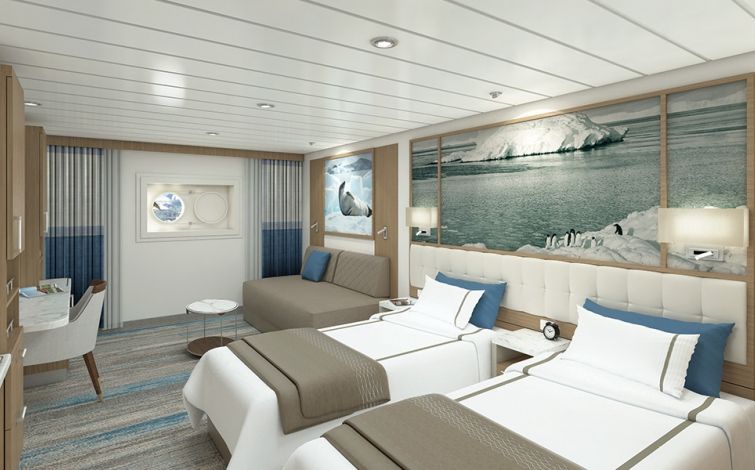
Cabin Inclusion
Amenities
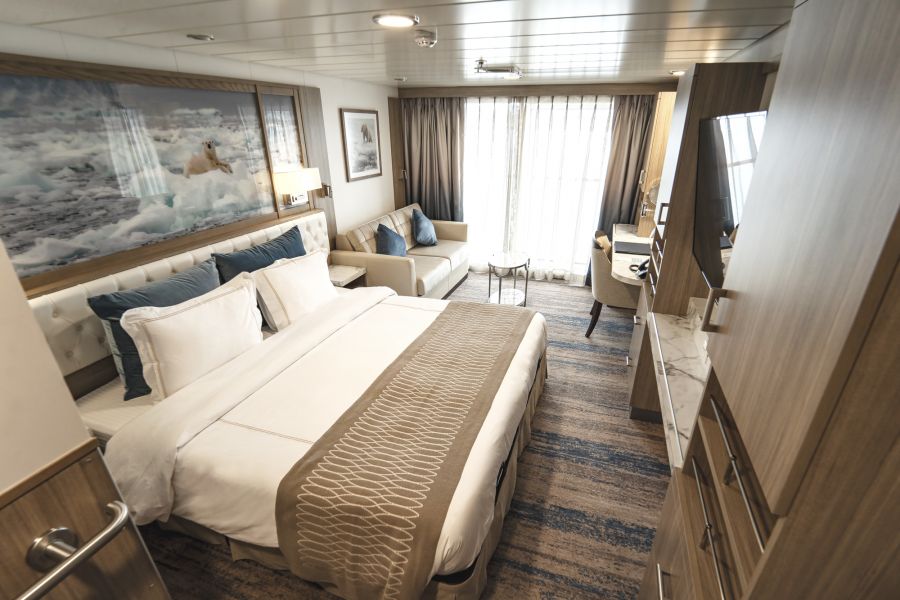
We have three cabin categories of our Balcony Staterooms. These are classified as A, B or C depending on the cabin size.
Cabin Inclusion
Amenities
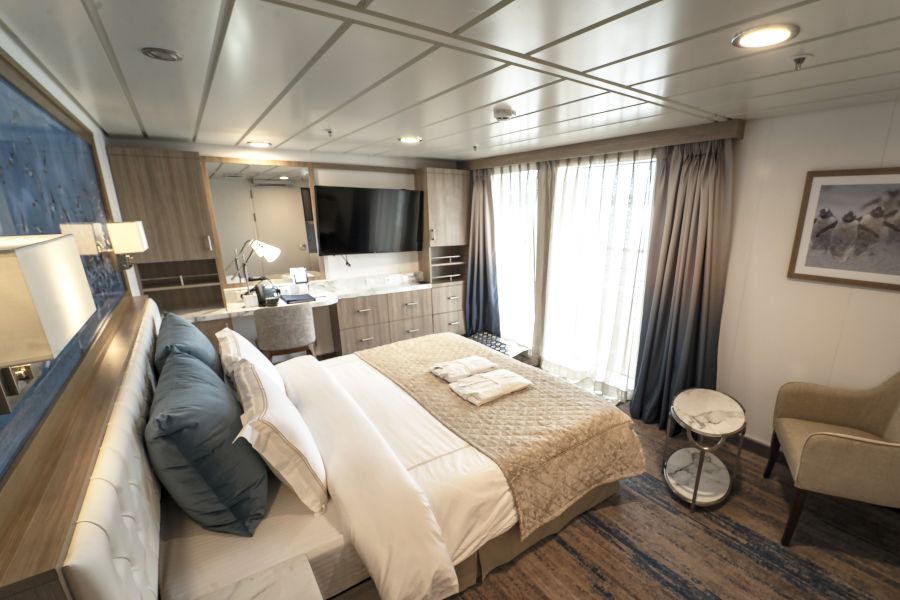
Cabin Inclusion
Some of these rooms are equipped with wheelchair accessible bathrooms.
Amenities
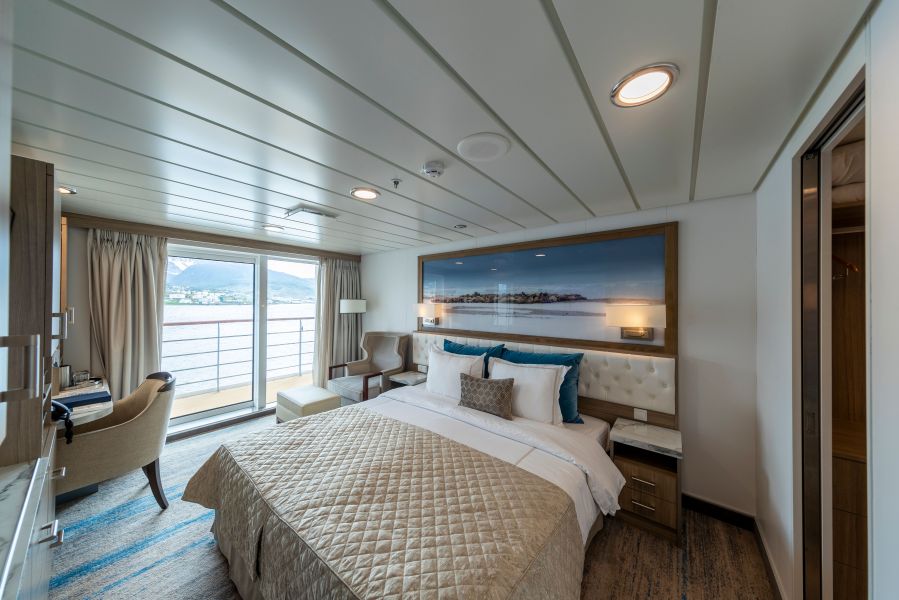
Cabin Inclusion
Amenities

Cabin Inclusion
*Valid on 1-hour massage or facial treatment only. Further details provided on board.
^Balcony Suites and Junior Suites stocked once only, not replenished. Captain’s Suite replenished as needed.
Amenities
The images shown are for illustration purposes only and may not be an exact representation of what you find on the ship.
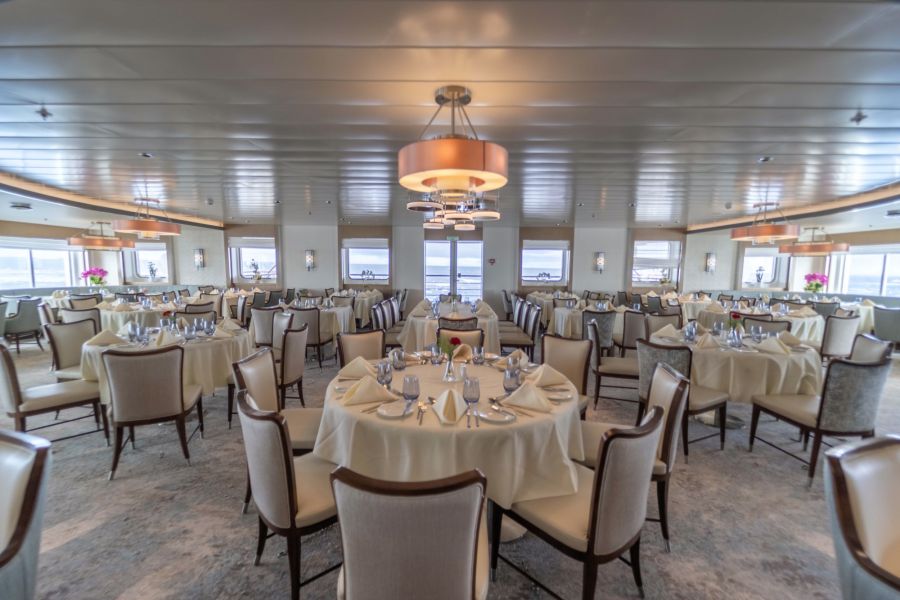
Meals are served in a large restaurant with family style dining, perfect to swap stories with your new expedition family. Additionally, a private dining area will also be available on request. Enjoy the range of house wine, beers and soft drinks included with dinner after a long day in the wild, preparing yourself for another exciting day to follow.
On the last day of your trip, the team on the Greg Mortimer put on a special farewell four-course dinner and cocktails – a perfect way to reflect on your time on the ship and consolidate lifelong friendships with the people you've met on-board.
The images shown are for illustration purposes only and may not be an exact representation of what you find on the ship.
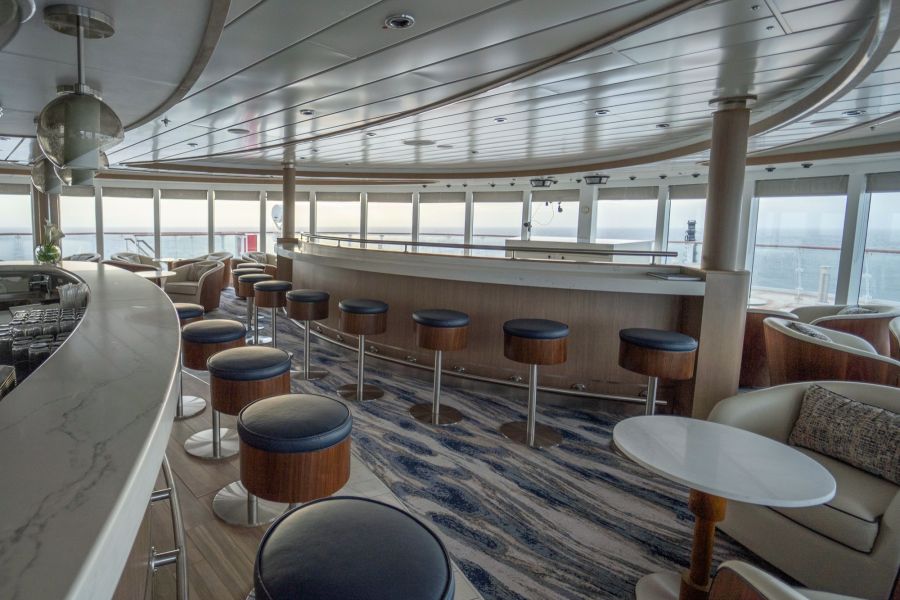
Let's face it – you don't want windowless rooms when travelling around some of the most beautiful locations around the world. This is why the Sylvia Earle is designed with plenty of dedicated observation spaces – ideal for keen bird spotters, wildlife watchers and those wanting to watch the scenery go past.
From the indoor 180-degree lounge and outdoor 360-degree open deck, both on deck 8, to the 270-degree open sundeck on level 7, there are plenty of observation points to share around the ship! If these are full, then you can take up a spot on one of the two hydraulic viewing platforms on deck 5.
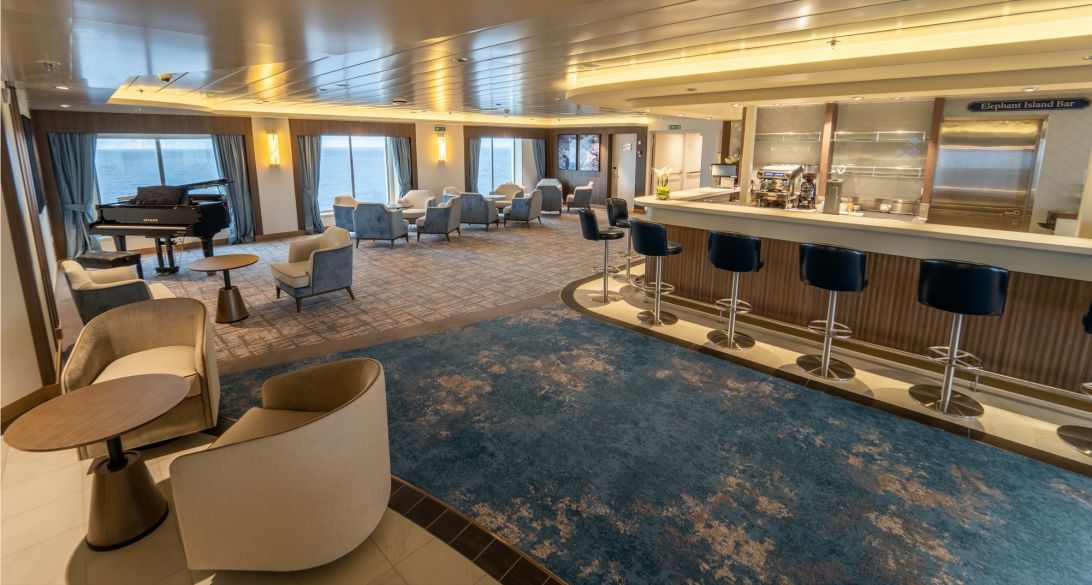
Communal meeting areas have always played a major role in fostering the warm camaraderie on board our ships. They are the heart of the expedition, where people meet to share tales from the day, swap photos, keep an eye out for wildlife and watch the sun go down.
The bars and lounges on board are refined yet inviting places to gather, with floor-to-ceiling windows offering stunning views, and of course friendly bartenders to shoot the breeze with.


The images shown are for illustration purposes only and may not be an exact representation of what you find on the ship.
The images shown are for illustration purposes only and may not be an exact representation of what you find on the ship.
| 15 nights aboard the Sylvia Earle | |||
| Fully-serviced accommodation in your chosen stateroom | |||
| An informative and entertaining lecture program by our team of experts | |||
| Complimentary 3-in-1 polar jacket and the use of gumboots | |||
| Entry fees to historic or tourist sites | |||
| Daily shore excursions, guided walks, Zodiac cruises and some activities | |||
| Daily breakfast, lunch and dinner including house wines, beers and soft drinks and afternoon tea and snacks | |||
| Complimentary use of fitness centre | |||
| Comprehensive pre-departure information kit and destination resource guide | |||
| Captain’s Welcome and Farewell Cocktail Reception including four-course dinner, house cocktails, house beer and wine, non-alcoholic beverages | |||
| Complimentary access to onboard medical doctor or clinic, if required | |||
| An experienced team of destination specialists and activity leaders | |||
| Pre-dinner cocktail hour including cold canapes and bar snacks | |||
| Photographic voyage log (post-voyage) | |||
| Port Taxes and Fees | |||
 | ABTA and ATOL Protection* | ||
Date 17th May 2023 |
Nts 16 |
Oceanview £9,596pp |
Balcony £9,836pp |
Suite £15,276pp |
Date 17th May 2023 |
Nts 16 |
Oceanview £9,596pp |
Balcony £9,836pp |
Suite £15,276pp |
| Oceanview staterooms from | £9,596pp | ||
| SASS | Aurora Stateroom Superior | £9,596pp | |
| Balcony staterooms from | £9,836pp | ||
| BSCS | Balcony Stateroom C (Forward / Aft) | £9,836pp | |
| BSBS | Balcony Stateroom B (Off Midship) | £10,396pp | |
| BSAS | Balcony Stateroom A (Midship) | £11,116pp | |
| SBSS | Balcony Stateroom Superior | £12,156pp | |
| Suite staterooms from | £15,276pp | ||
| JSS | Junior Suite | £15,276pp | |
| CSS | Captain's Suite | £18,076pp | |
Fusion Cruises when selling travel arrangements is a trading name of The Midcounties Co-operative Ltd. Fusion Cruises is an Accredited Body Member of Midcounties Co-operative Travel Consortium. (ABTA:P6652, ATOL:6053).
Book with Confidence. We are a Member of ABTA which means you have the benefit of ABTA’s assistance and Code of Conduct.
Some of the flights and flight-inclusive holidays on this website are financially protected by the ATOL scheme but ATOL protection does not apply to all holiday and travel services offered on this website. This website will provide you with information on the protection that applies in the case of each holiday and travel service offered before you make your booking. If you do not receive an ATOL Certificate then the booking will not be ATOL protected. If you do receive an ATOL Certificate but all parts of your trip are not listed on it, those parts will not be ATOL protected. Please see our booking conditions for information, or for more information about financial protection and the ATOL Certificate go to: www.caa.co.uk
